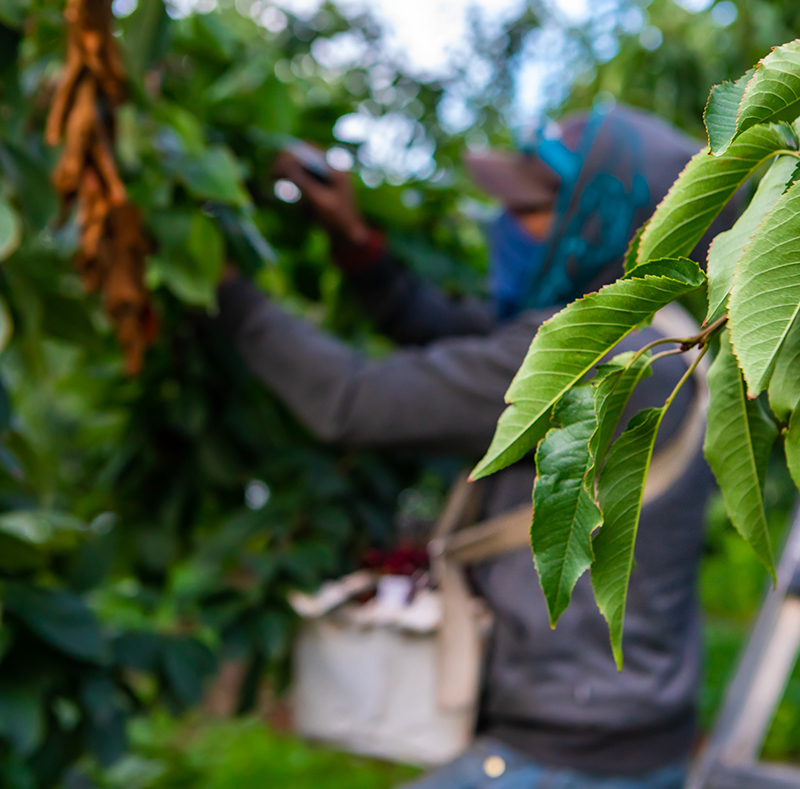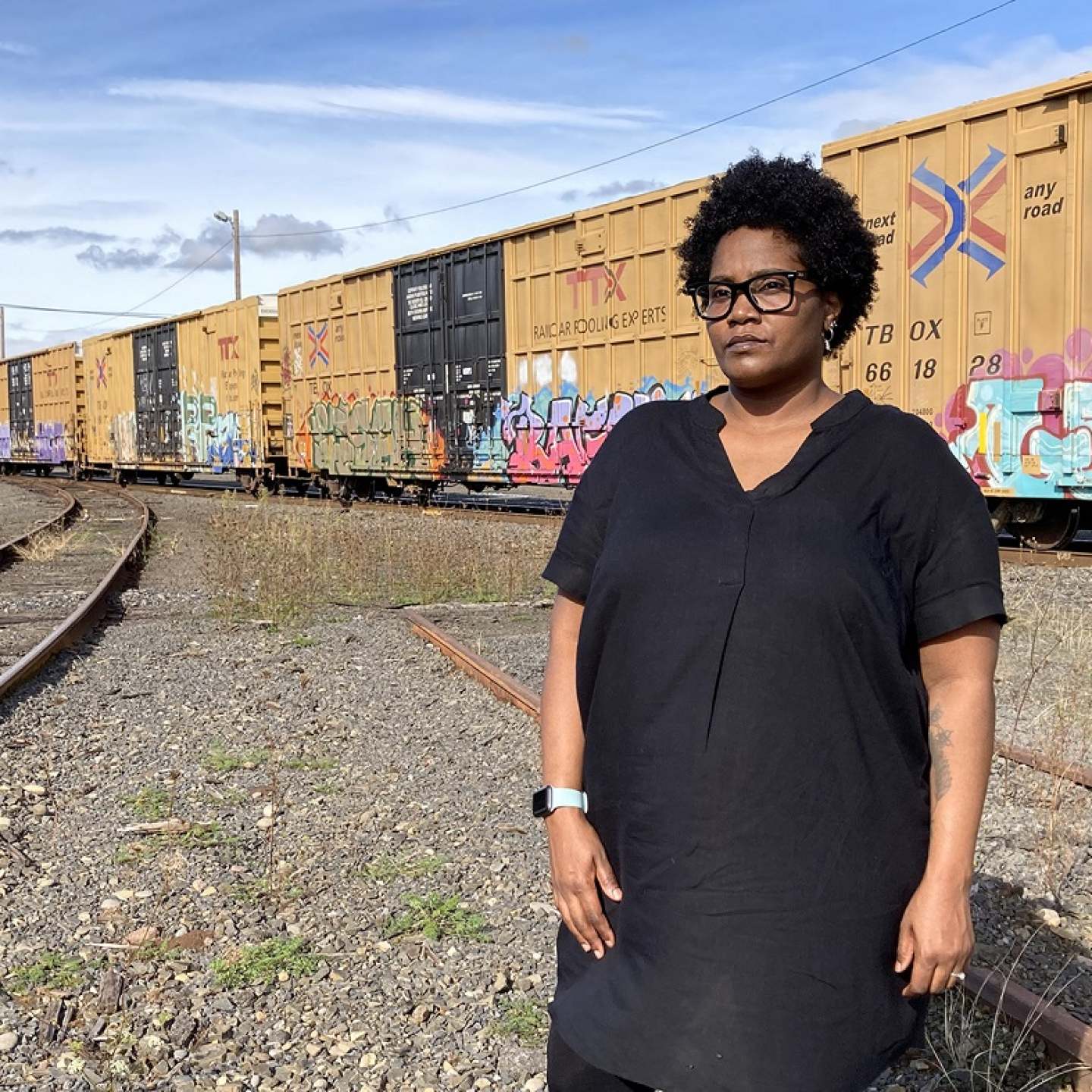This development highlights the power of grassroots action. Oregon’s new law on chlorpyrifos is stronger and more protective than the US EPA.
A Breath Of Fresh Air: Eugene's Bold Step Towards Pollution Control
Arjorie Arberry-Baribeault, West Eugene Community Organizer for Beyond Toxics.
On Monday, October 23rd, the Eugene City Council voted unanimously to adopt the concept of Public Health Protection Zoning, what we have been calling a Public Health Overlay Zone! The City Manager will next draft an ordinance to include public health requirements in Eugene’s zoning laws. This represents a historic win for environmental justice, as we will be the first city in Oregon to adopt this innovative concept!
I moved to west Eugene as a teenager in the ‘90s and later raised three children there.
While raising my children in west Eugene, we spent plenty of time in parks or swimming in the neighborhood pool. Our family lived in the Bethel School District where we embraced playing outdoors, engaged in team sports and enjoyed time in public spaces with friends and family. I tried to take my children to the park every day, rain or shine.
We felt safe and at home in west Eugene. Plus it was affordable in those days! Historically, housing tended to be less expensive in this community, which was crucial to our family, as it is to other low income, working class families. We felt a sense of security and belonging in the neighborhood; we never suspected the dangers that surrounded us or the threats of industrial pollution that would impact my family forever.

Zion and Arjorie
In the heart of Bethel, over 30 industrial facilities loom over the landscape, including wood preservation companies spewing dangerous air toxins regularly. Combined with the ceaseless traffic on 3 busy highways, our community is constantly inundated with diesel emissions on top of the industrial air pollutants. For years we breathed in air laden with dangerous industrial pollutants.

Polluting factories are a common sight near residential areas of West Eugene.
We were surrounded by industrial sources of pollution, but I had always thought, ‘they’re just doing business, right?’ Living so close to industry, it never bothered us that our homes were located near smokestacks that emitted clouds of "smoke." What they were releasing was not necessarily our concern. At the time I told myself things like “Surely, we wouldn't be subjected to anything that could hurt us”. And "Certainly, the city is aware of what can happen when factories are allowed to operate near homes, schools, parks and other community spaces." We had no clue that behind those innocent-looking smoke-stacks lay something more sinister than we ever dared to imagine.
While it was a blow to learn just how naive it was to believe that our city had strong public health regulations in place, my faith in society’s ability to protect public health from harm was completely shattered the day my family heard the doctor’s diagnosis: ‘Zion has Hodgkin’s Lymphoma’. I have shared my story of being a mother of a childhood cancer survivor before, but the impact of her battle and survival from illness changed my life. And, I believe, her difficult journey left a lasting impression on the power of community advocacy. With our victory from the Eugene City Council’s October vote*, my faith in the power of community action has been renewed and my hope for a better future restored! The struggles of folks in this neighborhood, who have been made vulnerable and burdened with sickness and in some cases death of loved ones, have finally been recognized as a cause for concern by the powers that be!
This new zoning ordinance will, potentially, take effect citywide in order to help protect the community from the dangers of industrial pollution in our neighborhoods. One of the ways this concept will improve the safety of our neighborhoods will be to create a quarter-mile buffer between industrial facilities and residential, park, and school zones. This is a brand new concept and it will take time to work out the details, but it represents an extraordinary moment in west Eugene’s history. This is a big victory for the environmental justice movement!
Thank you to all who have supported making history by your compelling testimonies and hard work to bring this into fruition. Congratulations, Eugene!

~ Arjorie Arberry-Baribeault, West Eugene Community Organizer
For more about Arjorie's journey, see the interactive presentation, "Beautician Turned Environmentalist" on ArcGIS's StoryMap
* Eugene council takes step to create rules they say will protect the city from polluters by Alan Torres, Eugene Register-Guard (PDF)
It’s National Public Health Week. Let’s tackle toxic chemicals!
Every child deserves a safe environment to grow in that allows them to become strong and healthy and develop to their full potential. During National Public Health Week, it's important to draw attention to the health impacts and risks from toxic chemicals in products and the places where children live, learn and play. It is now estimated that 10 million synthetic chemicals are added to the marketplace every year. They range from the chemicals in plastic toys, pesticides on our lawns and school grounds, and harmful additives in our personal care products that go directly onto our skin and are absorbed into our organs.
These chemicals can cause immediate and long-term harm. Toxic chemicals are linked to neurological damage which can leave a child with learning disabilities. Over time, chemicals can lead to a wide range of health problems from endocrine and reproductive disruption to cancer. Exposure to harmful chemicals in consumer products and the environment disproportionately impact communities of color and lower income communities that are more often exposed to cumulative toxins. It is often the case that cheaper and deadlier products are marketed to the most vulnerable members of our communities.
What is Oregon doing to address toxic chemicals?
Thankfully, there are three key bills addressing toxic chemicals this 2023 Session being led by Oregon Environmental Council and Beyond Toxics and their partners. We continue to advocate for and defend these bills from staunch opposition from the chemical and pesticide industry and demand that toxics be prioritized by our lawmakers.
This year, National Public Health Week coincides with an important deadline in Oregon’s legislative session, and thus determines what health-protective policies will, or will not, move forward. On April 4th, every bill currently being considered by the Oregon legislature must have been voted out of its first chamber committee.
What do these bills do, and what is their current status?
1) Toxic Free Schools (SB 426)
Oregon school districts and regulatory agencies currently lack funding, coordination and resources needed to implement safer pesticide use practices. As a result, unintentional yet illegal pesticide uses are occurring at Oregon schools. SB 426 will fix a 14-year unfunded mandate for schools and create a path towards modernized record keeping and safer choices for pest control under the Healthy and Safe Schools Act.
The Toxic Free Schools Act will:
SB 426 was voted out of the Senate Education Committee on March 30th and has been referred to the Joint Ways and Means Committee to address its fiscal impact.
Read more about Toxic Free Schools
2) Toxic Free Cosmetics (SB 546)
People assume personal and beauty products (collectively called “cosmetics”) are safe. But it is estimated there are over 10,000 chemicals in the beauty market today, and account for a $100 billion beauty industry. The Federal Food, Drug and Cosmetics Act (FDCA) has only restricted 11 chemicals since 1938, while the European Union has banned over 1800 chemicals.
Through SB 546, Oregon can require the public disclosure of all chemical ingredients on a company’s product webpage. Doing so is an accessible way for consumers to make educated purchasing decisions. Additionally, it will ban the sale of the worst chemicals in cosmetics and personal care products like many other states have.
SB 546 passed out of the Senate Energy and Environment Committee on March 28th, unanimously and bipartisan, and has been referred to the Joint Ways and Means Committee to address its fiscal impact.
Read more about Toxic Free Cosmetics.

Photo courtesy of Tanaphong Toochinda
3) Toxic Free Kids Modernization Act (HB 3043)
Thousands of chemicals lurk in products our kids use every day, and children are far more vulnerable to toxic chemicals than adults. HB 3043 builds on the success of Oregon’s 2015 Toxic Free Kids Act by strengthening protections for children’s health and streamlining business reporting requirements.
A modernized Toxic Free Kids Act will:
HB 3043 passed out of the House Committee on Climate and Energy on March 15th, also unanimously and bipartisan, and subsequently passed the full House 42-14 also on a bipartisan vote, on March 22nd. It heads to the Senate Energy and Environment Committee as its second chamber.
What Can you do?
In your day-to-day life, keep in mind ways that you can buy toxics-free or organic items to reduce your risk of chemical and pesticide exposure. When possible, consider reducing your use of cosmetics or products if you’re sensitive to chemicals. Be sure to wash hands and remove your shoes after playing on school fields.
In addition, contact legislators and urge them to act NOW to regulate toxic chemicals and protect public health for Oregonians. Let them know we are depending on them to help keep our families safe from harmful chemicals and pesticides at home and at school.
Authors:
Jamie Pang, Environmental Health Program Director, Oregon Environmental Council
Lisa Arkin, Executive Director, Beyond Toxics
Ask city for change to prevent more Baxter-like pollution issues now facing west Eugene
(this article was originally published as an opinion editorial in the May 15th edition of the Eugene Register-Guard)
For over 50 years, J.H. Baxter operated a wood treatment facility in West Eugene where wood products are infused with potent oil-based pesticides and chemical treatments. In recent months, J.H. Baxter, facing large civil penalties and an expensive environmental clean-up, announced that they would “mothball” their facility. The owners claimed they were faced with “market volatility” and “diminished returns” and concluded that “it simply doesn’t make financial sense to continue current operations at [their] Eugene facility.” Apparently, JH Baxter’s choice of operational methods, which never made moral or legal sense, is no longer financially sensible.
Celebrations from environmental justice advocates and neighborhood residents are justified. However, the decades of pollution violations, unpaid civil penalties, and unaddressed contamination caused by poorly regulated wastewater and harmful toxic air emissions mean that closed doors may be as much an act of evasion as an act of surrender.
Environmental sampling in the wake of yet another string of investigations has shown there are significant quantities of PCP leaching out from under the facility into surface and ground water and dioxin wafting out and settling in the surrounding neighborhood.
Dioxin, a toxic and persistent organic pollutant (POP) and a component of the biological-chemical weapon ‘Agent Orange’ is now a fixture of West Eugene’s public spaces, a glaring harm to properties, and substantial risk to residents. Per the Environmental Protection Agency (EPA): “Dioxins are highly toxic and can cause cancer, reproductive and developmental problems, damage to the immune system, and can interfere with hormones.”
A Community Effort for Change
Beyond Toxics and thousands of residents of West Eugene have raised the alarm on J.H. Baxter’s pollution for decades, citing noxious smells, illness, discomfort, and respiratory issues among other adverse health effects, including incidence of rare childhood cancer. J.H. Baxter has been cited with over twenty pollution violations in the last 30 years.
Despite laws and environmental protections codified to protect ‘public health and welfare,’ poison on the playground and pollution off the porch have repeatedly threatened residents of West Eugene. Today, nearly 40 Bethel residents wait to find out if their property is marked unsafe for children, unsafe to grow food, unfit for typical use.
Today’s antiquated laws, as codified, allow our state and federal government to permit harm and, functionally, designate sacrifice zones. And unfortunately, absent an injunction from a court or cease-and-desist order from either the DEQ or from the governor, these violations and cited penalties end nothing—to a company like JH Baxter, it’s just a cost of doing business.
Our communities and our regulatory agencies lack the legal tools necessary to hold chronic polluters like JH Baxter accountable to environmental regulations and fiscal responsibilities. A serious reconsideration of our planning, land use, and environmental protections is long overdue.
Proposed Changes In The Works
Beyond Toxics is proposing a series of impactful changes to Eugene’s local government. Top on our list 1) Restructure Land Use Compatibility Statements (LUCS) (a process involved with granting conditional use permits for development); 2) Codify a Public Health Overlay Zone (a new ordinance layering additional protections related to public health and equity to existing zoning regulations); 3) Create a Risk Bond requirement (a bond the polluter most hold to insure against significant risks of environmental and public harm posed by a new development or land use).
Since the inception of Beyond Toxics, we’ve been dedicated to addressing the root causes of toxic pollution. By working to dismantle entrenched and unfair legal loopholes and “perks” for polluters that allow unabated contamination with no accountability we will go a long way in the fight against these root causes. A vital part of that work includes updating land use laws and strengthening environmental regulations. Accomplishing these goals will provide lasting protections for all communities, in perpetuity.
~ Peter Jensen, Environmental Justice Law and Policy Extern and Lisa Arkin, Executive Director
City of Eugene Work Sessions
1) Addressing Chronic Toxic Polluters Work Session: Monday May 23 at 5:30 pm
MORE: https://www.eugene-or.gov/DocumentCenter/View/5448/Tentative-Working-Agenda
TAKE ACTION
Attend the work sessions via video conference
https://www.eugene-or.gov/3360/Webcasts-and-Meeting-Materials
See the "Live Sessions" section on that page to access live webcasts of City Council, Budget Committee or Planning Commission. The button for meeting that is currently live will be highlighted. Live sessions and recordings of previous meetings can also be accessed via our City of Eugene Public Meetings YouTube channel.
-------------------------------------------
Sign up to be on our e-alerts list to get notified about future City of Eugene work sessions
Farmworker Overtime Bill and its Potential Protective Health Outcomes

The Oregon Legislative 2022 session has come to an end with the successful passage of the high-profile Farmworker Overtime Bill, HB 4002, now awaiting Governor Brown’s signature. More than 900 testimonies were submitted to the House Committee of Business and Labor and another 520 testimonies were submitted to the Joint Committee on Farmworker over time, making sure that the public's voice was heard. The passage of this bill is a significant step forward in addressing structural racial barriers and inequities. The Farmworker Overtime Bill not only ensures that farmworkers are paid at time and a half their regular hourly rate for work done above the 40 hour week threshold, but from a public health point of view, it also has potentially protective health measures which may alleviate some of the stressors farmworkers are experiencing.

The 1938 Fair Labor Standard Act (FLSA) was signed by President Franklin D. Roosevelt.
It is important to note that the reason Congress enacted the Fair Labor Standard Act (FLSA) in 1938 was a result of “…labor conditions detrimental to the maintenance of the minimum standard of living necessary for health, efficiency, and general well-being of workers…” [1], and to ameliorate these working conditions a 40-hour weekly cap was set, making employers less frivolous with their demand on employees' time. However, this eighty year-old law has failed to guarantee overtime pay for farmworkers.
Unfortunatley, a long history of intitutionalized racism has excluded Black Farmworkers and Migrant farmworkers from the FLSA, meaning they have not received equal rights under this act. This legacy continues to harm all farmworkers. Agricultural work is labor-intensive. Farmworkers are subjected to multiple health and safety hazards in their work environment, including physical injuries, exposure to toxic pesticides, and extreme weather conditions that affect their health.
According to a report done by Oregon Health and Science University (OHSU) on farmworkers, working overtime routinely increases the risk of work-related injuries due to fatigue [2]. The Census of Fatal Occupational Injuries (CFOI) reported that the share of Hispanic or Latino workers fatally injured on the job increased from 20.4% in 2019 to 22.5 % in 2020 (which in numbers are 1,072 fatalities). 16% of these fatalities were related to exposure to harmful environments or substances and another 25% were attributed to falls and slips at the work site [3]. Moreover, the fatality rate for Hispanic or Latino workers was 4.5 deaths per 100,000 full time equivalent (FTE) workers in 2020 while the overall fatal work injury rate for 2020 was 3.4 fatalities per 100,000 FTE [4]. The difference is fatality rates indicate that Hispanic or Latino workers are more prone to fatal injuries due to the requirements of their jobs.

The OHSU report has also established a link between workers who routinely work overtime and the onset/progression of chronic health conditions of heart disease and diabetes. In addition, workers are at higher risk of developing heat-related illnesses such as heat exhaustion or heat stroke during extreme heat events [5]. Farmworkers' well-being and quality of life are also affected by long workdays. Frequently working overtime provides less time for family life and causes financial and logistical strain trying to maintain a functional household and childcare. [2]

These health stressors, which stem from long working hours, may be alleviated with the recently passed rule. By being more mindful of regular work hours and compensating workers for overtime labor, we hope to see multiple changes, including a decline in work-related injuries due to fatigue and a higher standard of living leading to reduced financial burdens on households. We are confident that these improvements will contribute to Oregon's economy and thereby increase the overall well-being of workers, their families and their communities.
By Galia Peleg,
Master in Public Health Fellow, Oregon Health and Science University
References
1.) 29 U.S.C. § 202(a) https://www.law.cornell.edu/uscode/text/29/202
2.) Oregon Health and Science University. (2021). Mandated, but not compensated: Exploring the multifaceted impacts of overtime on farm workers’ health, safety, and well-being. https://img1.wsimg.com/blobby/go/c8357af7-9c3e-4b52-9725-4de56f1d3cea/PCUN_White%20Paper-Overtime%20Pay_FINAL.pdf
3.) TABLE A-7. Fatal occupational injuries by worker characteristics and event or exposure, all united states, 2020. (2021, December 16). Bureau of Labor Statistics. https://www.bls.gov/iif/oshwc/cfoi/cftb0342.htm
4.) Bureau of Labor and Statistics. (2021, December 16). NATIONAL CENSUS OF FATAL OCCUPATIONAL INJURIES IN 2020 [Press release]. https://www.bls.gov/news.release/pdf/cfoi.pdf
5.) Castillo, F., Mora, A. M., Kayser, G. L., Vanos, J., Hyland, C., Yang, A. R., & Eskenazi, B. (2021). Environmental health threats to latino migrant farmworkers. Annual Review of Public Health, 42(1), 257–276. https://doi.org/10.1146/annurev-publhealth-012420-105014
Lay Of The Land (Use)
“I’m from the coast.” “I own a farm.” “My family have been ranchers for five generations.” Our sense of ourselves is integrated with the way we own and use land.
Equity Missing in Oregon Land Use Laws
We face a future full of challenges about the health of our communities and the impacts of a warming climate. Of the many intersections between environmental justice, health and climate change, one that is often overlooked is pesticide use.
At the most basic level of fossil fuel production reductions, pesticides are petrochemicals – toxic chemicals made from extracted oil and fracked gas. Agricultural pesticides also increase greenhouse gas emissions of nitrous oxide, a greenhouse gas 300 times more potent than carbon dioxide.
Breathing life into our leaders of color
“I can’t breathe!” One man’s dying words, choked to death by a Minneapolis police officer, has become the rallying cry of our era.
As George Floyd’s murder galvanized some of the largest and sustained protests in United States history, a respiratory pandemic swept through the world. Masked protestors surged in the streets, demanding a world where the right to breath was no longer determined by skin color.
Organizing for Environmental Justice
Teams from Beyond Toxics and the NAACP Eugene/Springfield came together in 2018 to start the process of organizing an Environmental Justice Pathways (EJP) Summit. The agenda we had prepared was jam packed with amazing speakers from throughout the state of Oregon and abroad.



















